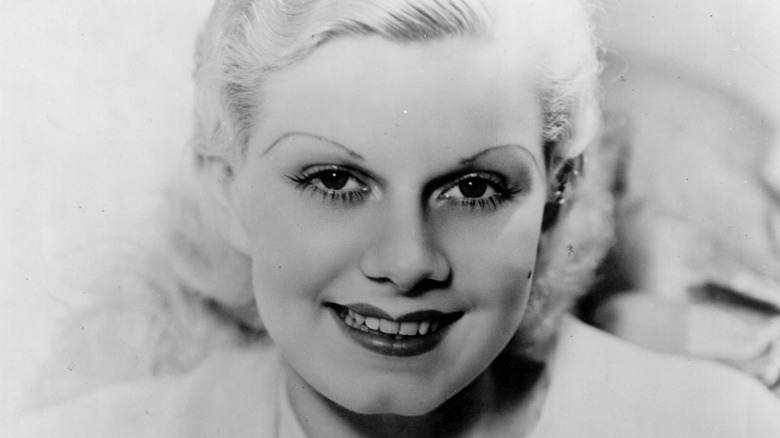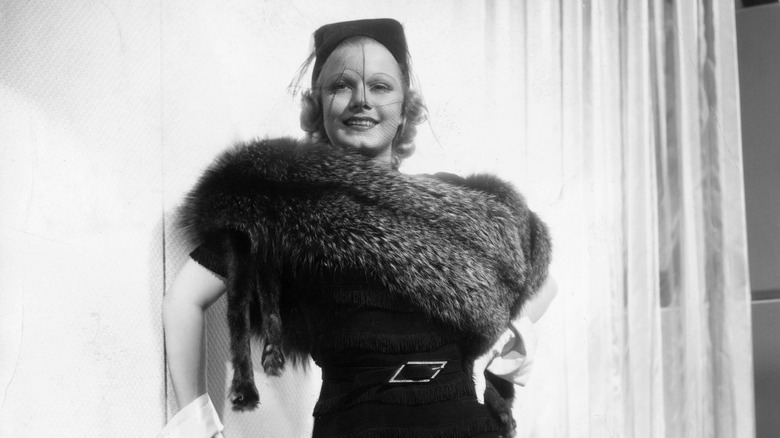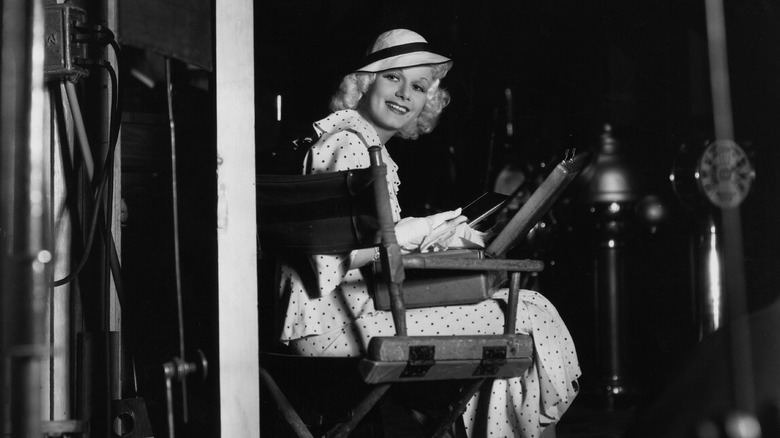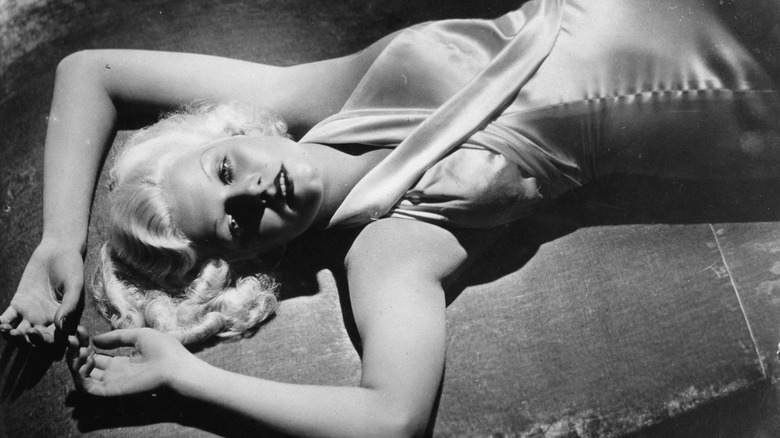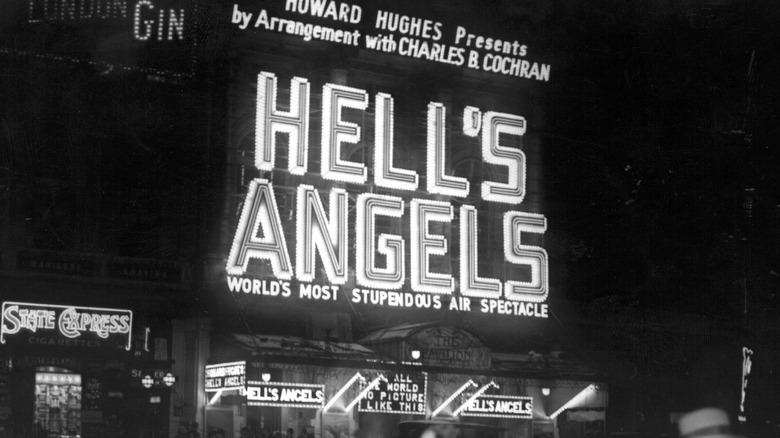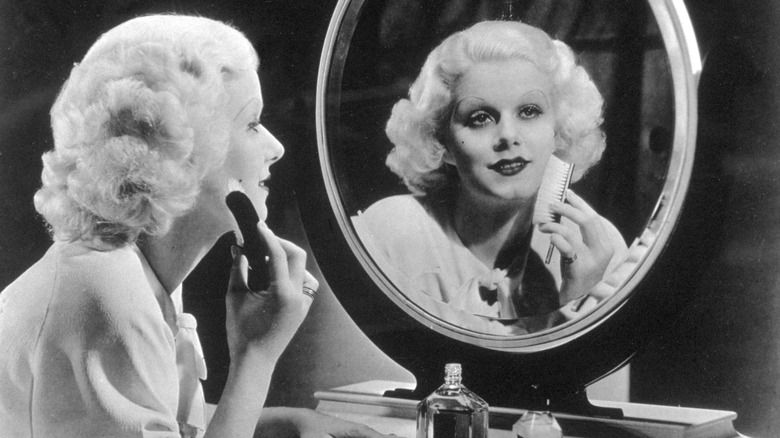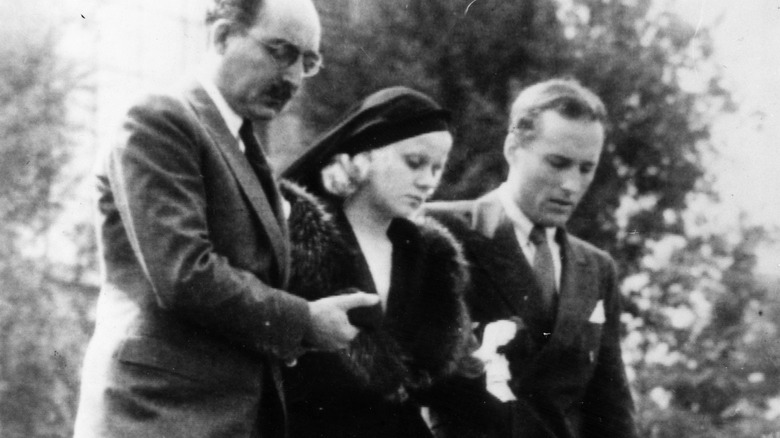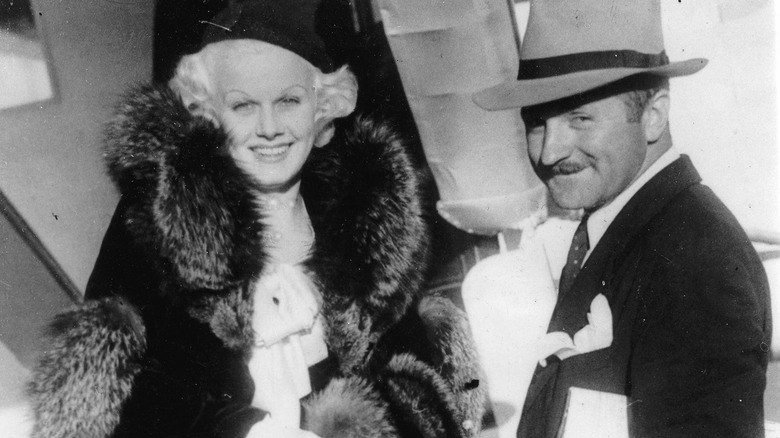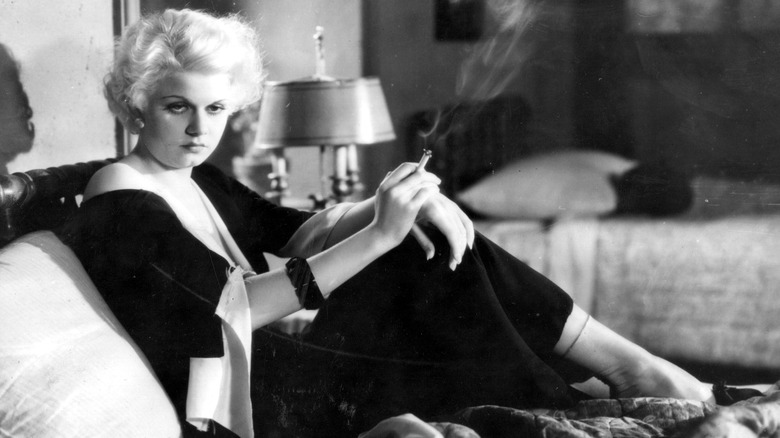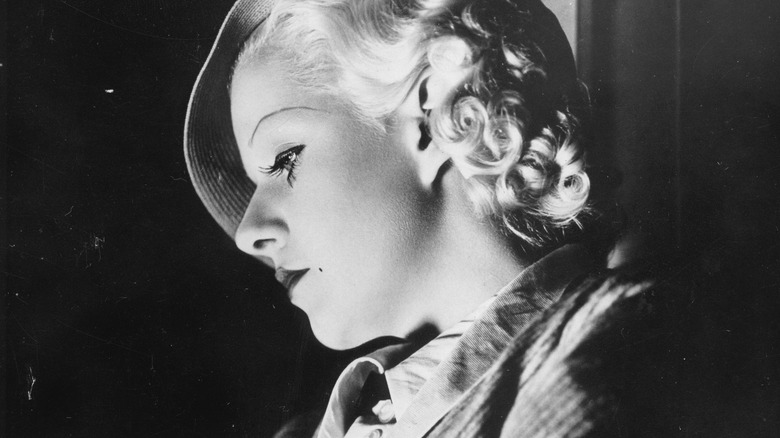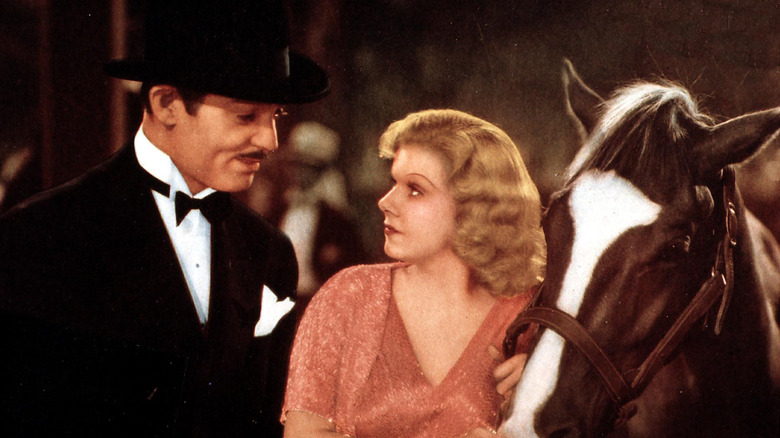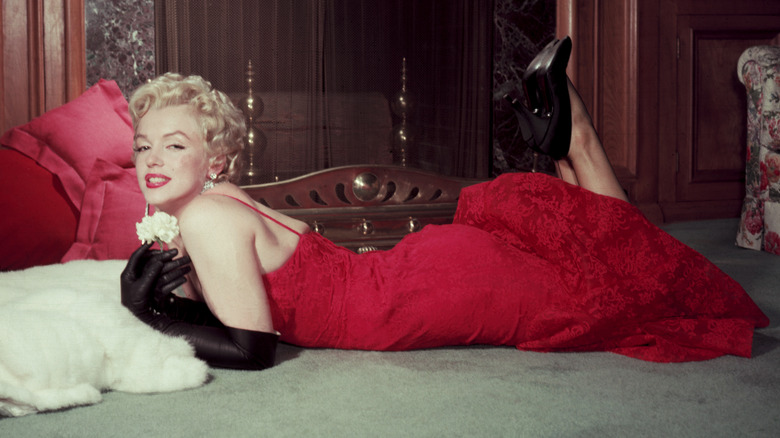The Untold Truth Of Jean Harlow
Decades before Marilyn Monroe burst onto the Hollywood scene as an iconic sex symbol, Jean Harlow was making waves as the first "blonde bombshell" (via Britannica). Daughter of relatively well-off parents, Harlow's teen years were cut short when she eloped at the young age of 16 and began her professional acting career shortly after that.
Initially discovered by studio execs for her stunning good looks, Harlow proved she could actually act, solidifying herself as a comedic gem and starting her career by appearing in Laurel and Hardy's uproariously funny 1929 short flick, "Double Whoopee," per Britannica. Within 10 years she appeared in 36 films — until her life was tragically cut short at the age of 26 in 1937, according to Harlow's official website. "She definitely created the mold for that spectacular-looking blond who was sexy and humorous," explained biographer Darrell Rooney to the Los Angeles Times, further noting, "She had a very winsome, childlike quality to her."
Along with genuine acting chops, Harlow was known for her upbeat disposition and wasn't a spoiled, A-list terror. A 1931 interview with Photoplay magazine was as glowing as ever, while in more recent years, authors have noted similar tales. "That heart of gold she played on the screen was very real," film historian Cari Beauchamp explained to the Los Angeles Times. Although Harlow's acting career was quite short, she undoubtedly made an impact on the industry. This is the untold truth of Jean Harlow.
Jean Harlow had numerous health struggles growing up
Jean Harlow was born on March 3, 1911, in Kansas City, Missouri. Per Britannica, her years as a toddler were most likely cushy, as the starlet's father was a successful dentist, yet after her parents separated, Harlow and her mother moved to Los Angeles. According to the actor's official website, Harlow's mother wouldn't allow her ex-husband to see their daughter, although it leads one to wonder if he would have been able to offer financial support for more qualified doctors once his daughter began her lifelong battle with various illnesses.
As revealed by The Atlantic, all before the age of 16, Harlow somehow survived having polio, meningitis, and scarlet fever. The latter, theorizes biographer David Stenn, was probably a contributing factor that led to her death at the age of 26, as her body slowly started declining thanks to chronic kidney degeneration (via "Fireball: Carole Lombard and the Mystery of Flight 3"). According to the Mayo Clinic, scarlet fever can become deadly for the kidneys without proper treatment. At the time of Harlow's illness, antibiotics still weren't a readily-available form of medication.
After Harlow became a Hollywood icon, her health struggles still didn't get better. As The Atlantic writes, during her 20s, the actor dealt with two abortions, influenza (multiple times), an appendectomy, and pneumonia.
She began acting at her mother's insistence
Unlike many of her A-list peers, Jean Harlow never aspired to become an actor. In fact, she initially showed no interest at all. As detailed by Country Living, while Harlow was still young, her mother (who was also named Jean Harlow but went by "Mother Jean") had serious dreams of being a Tinseltown legend. With her daughter in tow, Mother Jean divorced her husband and moved to Hollywood, hoping to make it big. Once she realized this would be harder than expected, she begrudgingly moved back to the Midwest. As for Harlow, life would soon change drastically.
According to "Uncle John's Bathroom Reader Plunges Into Hollywood," when Harlow was 16, her mother allowed her to marry the 21-year-old Chuck McGrew — mainly due to the large inheritance he was set to receive. After they got hitched (and McGrew's finances soared), the pair moved to Beverly Hills. One day, in the spring of 1928, the future star happened to be waiting for her aunt outside of Fox studios. After some studio execs noticed her, they pushed Harlow to share her phone number and began calling her. Although the blonde was initially disinterested, she shared the news with her fame-hungry mother, who pushed her to accept.
According to Country Living, Harlow began acting in Laurel and Hardy short films, morphing into a comedic great. As her Tinseltown career started heating up, her marriage suffered, and Harlow and McGrew divorced after two years. According to Slate, he wouldn't allow his wife to become a star.
Jean Harlow: the first platinum blonde
Once Hollywood bagged its new star, studio execs started thinking about how to craft Jean Harlow's glamorous image. As it turns out, Harlow's instantly-recognizable platinum blonde locks came by way of business tycoon and film director Howard Hughes. According to The Atlantic, in the late '20s and early '30s, although people would dye their hair, the exact shade of platinum blonde simply didn't exist. After Hughes realized he was working with a budding A-lister, he decided to give Harlow her own on-camera persona — just how many other starlets of the time had.
The result? Per The Atlantic, after sitting with his publicity director and rejecting ideas such as "Blonde Landslide" and "Darling Cyclone," the pair came up with "Platinum Blonde." Similar to how the winner of a public contest selected Joan Crawford's name, Hughes declared he would reward a hairdresser with $10,000 for the perfect blonde hair color. As Harlow's stylist, Alfred Pagano, later revealed, he used peroxide, ammonia, Clorox, and Lux flakes once a week to maintain her tresses (via The Atlantic).
Of course, this process is incredibly severe, and Harlow's hair began falling out near the end of her life. Nevertheless, this didn't stop women from wanting to emulate her look, and according to the actor's official website, as she grew in popularity, peroxide sales in America soared.
Her first major role was in a film that resulted in four deaths
In 1930, Jean Harlow solidified herself as Hollywood's hottest new blonde bombshell, thanks to Howard Hughes' action flick, "Hell's Angels." While the movie put the then-19-year-old on the map, production for the film was wrought with tragedy.
Hughes, a wealthy business tycoon, moved to Hollywood to try his hand at making movies near the end of the 1920s, per Britannica. When he started production on "Hell's Angels" in 1927, he also received his piloting license, which he decided to put to use for the war film, showcasing various aerial stunts (via National Air and Space Museum). Early on during production, the filmmaker got a little cocky, ultimately crashing a World War I plane and, thankfully, surviving. However, not everyone was so lucky. Per HistoryNet, he leased over 40 planes, hiring professional pilots to fly in the movie — and three sadly perished. After running into tension wires landing the plane, Al Johnson burned himself and died the next day. C.K. Phillips died after crashing an aircraft, while pilot Rupert Macalister passed away of unexplained circumstances. Along with the aviators, mechanic Phil Jones perished while operating a smoke machine and forgot to get out of the way during a crash scene.
According to the National Air and Space Museum, Hughes spent almost a whopping $4 million to make the flick over the course of three years. It ultimately became the first major Hollywood blockbuster action movie, while Hughes' aerial scenes were praised for their authenticity and incredible camera work.
She had to change her acting style due to the Hays Code
As multiple-reel films began appearing in America at the turn of the century, audiences finally had a new and exciting form of entertainment like nothing they've ever experienced. In fact, even before "talking" pictures were released at the end of the 1920s, these early movies were still revolutionary and daring, portraying various scenes of violence and sex, per PBS.
As detailed by The Guardian, movie studios began pushing the boundaries even further, as American audiences couldn't justify spending money on entertainment well into the Great Depression — unless more gratuitous sequences were being shown. Paramount's Mae West tantalized audiences with flirty innuendos, while Jean Harlow at MGM would reportedly perk up her nipples by icing them before shooting scenes in thin dresses. This period of raunchy filmmaking lasted from 1929 to 1934 and was known as "pre-Code Hollywood" (via Refinery29).
Of course, these morally questionable scenes didn't sit well with Catholic religious leaders, along with the Motion Picture Association of America. In 1930, The Hays Code was written, taking full effect four years later. These sets of rules, per PBS, declared that "no picture shall be produced which will lower the moral standards of those who see it." As such, the entire scope of Hollywood changed, lasting until 1968. Many starlets had to alter their total images, and Harlow, who once shocked audiences with her nudity in 1932's "Red-Headed Woman," suddenly found herself having to play quintessentially sweet girl-next-door-type roles.
The tragedy of Jean Harlow's second marriage
By the time the 1930s rolled around, Jean Harlow was a bonafide star. According to TCM, the blonde starlet was under contract with producer Howard Hughes, but on her 21st birthday in April 1932, she was bought out by MGM. The famed production company was an interesting choice for Harlow, as studio head Louis B. Mayer didn't think the actor's racy image was a proper fit for his more family-friendly company. Nevertheless, she had Paul Bern — another MGM higher-up who convinced Mayer to sign her – to thank.
Three months later, Harlow married Bern — yet their union only lasted a mere two months. While Harlow was off filming the drama "Red Dust," Bern shot himself in their home, leaving a suicide note for his wife. Per The Sunday Post, it read, "Dearest dear, [unfortunately] this is the only way to make good the frightful wrong I have done you and to wipe out my abject humiliation ... You understand that last night was only a comedy." While Harlow claimed she had no idea what he meant in his letter, another scandal unfolded.
Bern was married once before to Dorothy Millette — whom he never divorced when he wed Harlow, per SFGate. Millette reportedly suffered from mental health struggles, and her estranged husband supported her financially. However, she discovered that before his death, he made changes to his will that cut Milette out entirely. Knowing she had no money to her name, she died by suicide just days after Bern's passing.
If you or anyone you know is having suicidal thoughts, please call the National Suicide Prevention Lifeline at 1-800-273-TALK (8255).
While she was at the peak of her career, her personal life was crumbling
In the early 1930s, Jean Harlow's career couldn't have been going better. In 1932, she starred in Victor Fleming's comedy "Bombshell," which saw the director having to play his scenes at double the speed to ensure the film didn't last longer than 90 minutes (via Slate). The flick's rapid-fire pace not only became a staple of the decade's comedy genre, but it also cemented Harlow as a comedic delight — all while retaining her bombshell image.
According to Slate, the following year solidified Harlow as one of Hollywood's top earners, thanks to her role in "Dinner at Eight," showing that even having the blonde starlet appear in a minor role was still a major box office draw. Yet, although her career was at an all-time high, her personal struggles only worsened. Per Country Living, Harlow was still struggling over the death of her second husband, Paul Bern, but slowly began dating again, finding herself spending time with boxer Max Baer — a separated man yet to go through with his divorce. After Baer's estranged wife threatened to name Harlow in divorce proceedings and cited adultery as the cause of their marriage failing, MGM forced the actor to marry cinematographer Harold Rosson, saving the family-friendly studio from any controversy.
Sadly, Harlow's marriage to Rosson only lasted eight months, as she was hospitalized for an emergency appendectomy. As Slate notes, the blonde struggled with alcoholism during this time, which only exacerbated her lifelong health problems.
If you or anyone you know is struggling with addiction issues, help is available. Visit the Substance Abuse and Mental Health Services Administration website or contact SAMHSA's National Helpline at 1-800-662-HELP (4357).
The final two years of her life were incredibly painful
After eight months of living with her third husband, cinematographer Harold Rosson, Jean Harlow was rushed to the hospital for an emergency appendectomy in 1933. As revealed by Slate, the "Hell's Angels" star then went to live with her mother, who was dead-set on fixing her daughter's growing problems with alcoholism.
While it would be nice to believe that Harlow's mother took in her daughter solely out of altruistic concerns, that wasn't the case. The star had reportedly gained some weight during this time, and Mother Jean knew that meant Harlow's days in the spotlight were suddenly numbered. She put her daughter on a bleak diet consisting of some cottage cheese, a slice of pineapple, and one carrot for the entire day, which only worsened Harlow's physical state. As Slate notes, the once lively-looking actor was suddenly left with a swollen, tired face, a bloated belly, and hair that had begun to fall out.
It's not just the visible physical struggles that plagued Harlow, however. As detailed by Country Living, she also had a painful trip to the dentist to remove four wisdom teeth, which caused her heart to stop beating altogether briefly. Two months later, while working on the 1937 flick "Saratoga," Harlow discovered that she was suffering from an infection due to the dental surgery. Per The Atlantic, the actor was hospitalized yet again, and when her co-star Clark Gable visited her, he later recalled that the experience was like "kissing a dead person, a rotting person."
If you or anyone you know is struggling with addiction issues, help is available. Visit the Substance Abuse and Mental Health Services Administration website or contact SAMHSA's National Helpline at 1-800-662-HELP (4357).
Jean Harlow died heartbreakingly young
Sadly, Jean Harlow only lived to the age of 26. According to Slate, things went downhill for the actor by the mid-1930s, when she moved back in with her mother after an emergency appendectomy. By 1937, Harlow was struggling with depression (perhaps due to the death of her second husband, Paul Bern) and alcoholism, yet decided she had the strength to film "Saratoga" — and that's when things went incredibly downhill.
Right before she was due to start shooting the romantic comedy, Harlow had dental surgery for the removal of four wisdom teeth, which resulted in a serious infection, per Slate. By the time the star began filming in May, she also complained of stomach pain. First brushed off as the flu and then a swollen gallbladder, Harlow was prescribed dextrose injections, and her condition only worsened. According to The Atlantic, she looked nothing like herself by this point, with her swollen body twice the size due to water weight.
As Slate explains, another doctor came to visit the blonde starlet, who deduced that the dextrose injections were slowly killing her, as it was problems with her kidneys that she was having instead of her gallbladder. By June 3, Harlow allegedly felt better and was aiming to return to set, yet only four days later, she was pronounced dead. It's alleged that when a friend came to visit the actor in her final days, they assured her she would get better, to which Harlow replied, "I don't want to" (via Slate).
If you or someone you know is struggling with mental health, please contact the Crisis Text Line by texting HOME to 741741, call the National Alliance on Mental Illness helpline at 1-800-950-NAMI (6264), or visit the National Institute of Mental Health website.
Her final film was the biggest box office hit of the year
Jean Harlow died on June 7, 1937, while still shooting the romantic comedy "Saratoga" alongside Clark Gable. Right before her death, it was evident she was nearing the end, and as TCM reveals, even on camera, her face appeared bloated and strange in color. Nevertheless, Harlow, who didn't want to let anyone down, demanded to keep acting.
After her death, director Jack Conway ran into a snag: "Saratoga" was 90 percent completed, but there were still scenes to be shot of the blonde starlet. Per TCM, the filmmaker hired Mary Dees as a stand-in, giving her big hats or binoculars to hide her face, while Paula Winslowe was taken on to dub the deceased actor's voice. Gable, who became friends with Harlow over the course of his Hollywood career, found the experience bizarre. "I feel like I've been holding a ghost in my arms," the actor reportedly said after working with Dees (via "Clark Gable: A Biography").
"Saratoga" was released just over a month after Harlow's death, and fans of the blonde icon lapped it up. As revealed by TCM, it was a hit for MGM, becoming the biggest box office hit of the year.
Marilyn Monroe was greatly inspired by Jean Harlow
Marilyn Monroe may take the cake as the first Hollywood legend to come to mind whenever the phrase "blonde bombshell" is uttered, but it turns out Jean Harlow heavily inspired her. Monroe, who was still a preteen while Harlow was making her rounds as Tinseltown's hottest commodity, no doubt took inspiration from the original sultry star. According to Vogue, the "Some Like It Hot" actor used the same hair stylist as Harlow, Pearl Porterfield, who would dye Monroe's natural brown tresses the same platinum blonde shade every three weeks using peroxide and bleach highlights.
As Monroe's career gained steam, she starred in the 1953 noir thriller "Niagara," which is when the comparisons to Harlow began picking up steam. As the New York World-Telegram & Sun declared at the time (via How Stuff Works), "Hollywood took 14 years, three-score screen tests, and a couple of million dollars to find a successor to Jean Harlow." Headlines like these must have delighted Monroe, and as her friend, Amy Greene revealed (via "Marilyn Monroe: The Biography"), "She really wanted to be Jean Harlow."
Six years before Monroe's own tragic death in 1962, The New York Times published an article revealing that a Harlow biopic was in the works, and Monroe was the top pick for the role of the legendary star. Sadly, it never worked out. Interestingly enough, according to Greene, Monroe once told her of an eerie premonition that she would die young — just like her idol. She passed at the age of 36.
